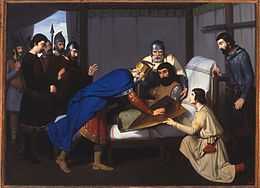Claudi Lorenzale
.jpg)
by Antoni Caba (1889)

Claudi Lorenzale i Sugrañes (December 8, 1814, Barcelona - March 31, 1889, Barcelona) was a Catalonian painter, associated with the German Nazarene movement and local efforts to recover the history of the Catalan region.
Biography
His father was a hatter of Italian origin. He began to study painting in Murcia at the age of twelve and, after 1830, was enrolled at the Escola de la Llotja in Barcelona, where he studied under Pelegrí Clavé and was awarded the first prize in painting for his work "Sísara derrotat per Barac" (The Defeat of Sisera by Barak), in 1837.[1] That same year, he travelled to Rome, accompanied by fellow painter Pau Milà (a follower of the Nazarene artist Friedrich Overbeck), and came under Overbeck's influence. He continued his education there at the Accademia di San Luca,[1] where he also received the first prize for painting.
Upon his return to Barcelona in 1844, he began a career devoted to artistic purity, inspired by Medieval art and the teachings of Overbeck. In pursuit of that goal, he founded his own Academy, which became widely known. His prestige as a teacher reached its peak in 1851 when he was named an Associate Professor of the graduate school at the Escola. The following year, he became a full Professor and, in 1858, he became the Director,[1] a post he filled until 1885. He retired from the Academy three years later. Among his best-known students were Marià Fortuny, Antoni Caba and Tomás Padró.
References
- ↑ 1.0 1.1 1.2 Biography @ Gran Enciclopèdia Catalana website
Further reading
- DDAA. La col•lecció Raimon Casellas. Publication of MNAC/Museo del Prado, 1992. ISBN 84-87317-21-9. (Cataglog of an exhibition held at the Palau Nacional from July 28 to September 20, 1992)
- Montserrat Gumà,(ed.) Guia del Museu Nacional d'Art de Catalunya. Barcelona: Publicacions del MNAC, 2004. ISBN 84-8043-136-9
- Enciclopèdia Espasa, Vol. 67, pg. 1560 ISBN 84-239-4567-7
- Josep Masriera y Manovens, “En el Círculo” (necrological text about Claudi Lorenzale), La Vanguardia, May 14, 1889, p. 1
External links
| Wikimedia Commons has media related to Claudi Lorenzale. |
- Paintings by Lorenzale in the Catalog of the Reial Acadèmia Catalana de Belles Arts de Sant Jordi